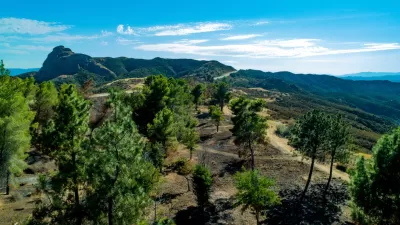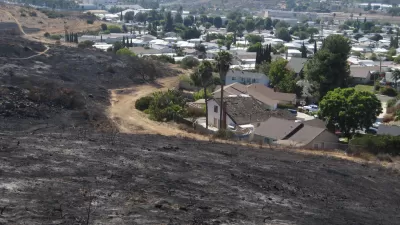In Colorado and the West, the most desirable real estate is also the most likely to burn, writes Michael Kodas.
"It's no surprise that people like to live near forests and mountains," writes Kodas, "but that's precisely where wildfires occur. And because those new residents naturally want to keep their homes safe, they demand that small, otherwise beneficial fires be put out if those blazes threaten their property, which causes forests to become unnaturally thick with unhealthy trees just waiting for a spark. And sparks are exactly what humans often provide."
"It's a vicious cycle: more building in the wildland urban interface [WUI], more property at risk, more firefighting, more fire-prone forests (and in the age of climate change, more hot, dry weather). All of which helps explain why, across the West over the last 20 years, fighting fires has gone from taking up 14 percent of the U.S. Forest Service's budget to almost half of it."
"'Everybody knows that firefighting costs are going up, and everybody knows the WUI has a lot to do with it,' says Ray Rasker, director of Headwaters Economics, an independent research group in Bozeman, Montana. According to the group's data, the U.S. government is spending as much as $3 billion a year to fight wildfires -- twice what was being spent 10 years ago. 'About a third of those costs are for defending homes,' Rasker adds."
Thanks to OnEarth
FULL STORY: Life on the Edge (of Wildfire)

Study: Maui’s Plan to Convert Vacation Rentals to Long-Term Housing Could Cause Nearly $1 Billion Economic Loss
The plan would reduce visitor accommodation by 25,% resulting in 1,900 jobs lost.

Alabama: Trump Terminates Settlements for Black Communities Harmed By Raw Sewage
Trump deemed the landmark civil rights agreement “illegal DEI and environmental justice policy.”

North Texas Transit Leaders Tout Benefits of TOD for Growing Region
At a summit focused on transit-oriented development, policymakers discussed how North Texas’ expanded light rail system can serve as a tool for economic growth.

San Diego County Sees a Rise in Urban Coyotes
San Diego County experiences a rise in urban coyotes, as sightings become prevalent throughout its urban neighbourhoods and surrounding areas.

Los Angeles County Invests in Wildfire Recovery for Parks, Trails, and Open Space
The $4.25 million RESTORE Program supports the recovery of parks, trails, and open spaces damaged by the January 2025 wildfires through targeted grants that promote community healing, wildfire resilience, and equitable access to nature.

Nevada Bills Aim to Establish Home Insurance Assurance Amidst Wildfire Risk
Republican sponsor hopes the FAIR plan would be “a true market of last resort.”
Urban Design for Planners 1: Software Tools
This six-course series explores essential urban design concepts using open source software and equips planners with the tools they need to participate fully in the urban design process.
Planning for Universal Design
Learn the tools for implementing Universal Design in planning regulations.
Alamo Area Metropolitan Planning Organization
City of Santa Clarita
Institute for Housing and Urban Development Studies (IHS)
City of Grandview
Harvard GSD Executive Education
Toledo-Lucas County Plan Commissions
Salt Lake City
NYU Wagner Graduate School of Public Service





























